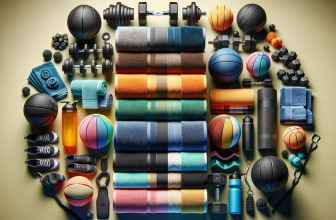
Are you ready to elevate your game from the casual tennis hits to a more serious level of play? Choosing the best intermediate tennis racket can be the transformative step you need. With an overwhelming array of options on the market, how do you discern the racket that’s just right for your game? Let’s delve into the heart of tennis gear to discover the top choices that can potentially take your on-court performance to the next level.
Our Top Picks
Our #1 Top Pick: Babolat Pure Drive
The Babolat Pure Drive is celebrated among intermediate players for its perfect blend of power and control. The racket is engineered with FSI Power Technology, which stands for Frame String Interaction Technology, geared towards expanding the sweet spot and generating more power. The diamond grommets and innovative string pattern allow for increased string movement, thus enhancing the ball impact.
You’ll appreciate the Pure Drive’s Cortex Pure Feel feature, designed to reduce vibrations and provide a much smoother feel upon contact. It has a 100-square-inch head and weighs around 11.2 ounces when strung, providing enough mass to generate power without tiring you out. Ideal for players who seek to add a bit more punch and spin to their strokes while enjoying a responsive and comfortable feel.
Pick #2: Wilson Clash 100
Next in line is the Wilson Clash 100, noted for its revolutionary flexibility without compromising on stability. The racket employs FreeFlex technology, which uses proprietary carbon mapping to enable the frame to bend in all-new dimensions. This allows for a boost in ball pocketing and control. It also features StableSmart frame geometry, which maintains excellent performance even with the newfound flexibility.
With a sweet spot that graciously forgives off-center hits and a 100-square-inch head, the Clash 100 is the go-to racket for intermediate players looking to improve their game with increased control and comfort. Weighing 11 ounces strung, the racket offers a lighter frame, making it easier to maneuver during intense play while still managing to deliver clean and powerful shots.
Pick #3: HEAD Graphene 360+ Speed MP
The HEAD Graphene 360+ Speed MP stands out for incorporating Graphene 360+ technology, characterized by combining Graphene 360’s energy transfer and innovative spiralfibers for an enhanced flex and clean impact feel. This means players get a racket that not only supports power but also lends a comfortable touch to every swing.
It has a 100-square-inch head and a 16×19 string pattern, which offers a balanced area for both control and power – a dynamic duo that intermediate players tend to seek. Weighing just under 11 ounces strung, the racket allows for swift swings while contributing sufficient mass behind the ball, making it suitable for a wide range of playing styles.
Pick #4: Yonex EZONE 98
The Yonex EZONE 98 is more than just a smart choice; it’s a precision instrument for intermediate players who favor both power and pinpoint accuracy. It incorporates Yonex’s iconic Isometric head shape, which enlarges the sweet spot for more consistent shot-making. The Oval Pressed Shaft (OPS) provides improved spin and control by increasing flex in the racket’s throat.
The EZONE 98 is celebrated for the vibration dampening mesh within its handle, providing a comfortable and arm-friendly feel. Weighing approximately 11.4 ounces strung and boasting a 98-square-inch head, this racket is geared towards intermediate players who are uncompromising about the feel and control of their swings.
Pick #5: Prince Textreme Warrior 100
Prince’s Textreme Warrior 100 is renowned for incorporating Textreme — a kind of carbon fiber known for its high stiffness-to-weight ratio — imparting phenomenal torsional stability and a lively response upon strike. With its 100-square-inch head and an even balance, it provides an attractive blend of speed, spin, and precision.
This racket is slightly heavier, around 11.5 ounces strung, making it suitable for intermediate players who prefer rackets with a bit more heft behind their swings. Moreover, it offers string pattern variations to cater to different playing preferences, delivering a personalized feel that so many intermediate players appreciate.
What to Know Before You Buy
- Level Appropriateness: Understand where you fall skill-wise before investing in a racket. Intermediate rackets are designed for players who have mastered the basics and need a racket to help refine their skills.
- Racket Attributes: Pay attention to the head size, weight, balance, and string pattern, as these will greatly influence your stroke production and comfort.
- Playstyle Consideration: Your playstyle should influence your racket choice. Whether you’re a baseline power player or a touch-and-feel net player, there’s a racket built to complement your style.
Factors to Consider Before Buying
- Balance: A head-light racket will provide more control and maneuverability, while a head-heavy racket can give more power. Consider trying different balances to see what matches your style.
- String Tension: Higher string tensions offer more control, while lower tensions provide more power. Intermediate players often experiment with tension to find the right balance.
- Racket Flexibility: A stiffer racket transfers more power to the ball, while a more flexible frame offers better control and may reduce the risk of arm injuries.
- Player’s Physicality: Consider your physical strength and fitness level. A heavier racket can provide more stability and power but may lead to fatigue if you’re not used to it.
- Technology: Racket technology evolves constantly. Seek out rackets with technologies that align with your goals, whether it’s reducing vibration, enhancing spin, or improving control.
Why Trust ChooseRight?
At ChooseRight, we take our recommendations seriously. Our review process includes hands-on testing, analyzing thousands of user reviews, and consulting with professional coaches and players. This thorough approach ensures that we only suggest the best products tailored to intermediate players. Rest assured, the rackets highlighted here are among the best reviewed and most endorsed in the tennis community.
Finishing Thoughts
Finding the best intermediate tennis racket is a journey unique to each player. It’s about matching the racket’s capabilities to your current needs and future aspirations on the court. Armed with knowledge and an understanding of what to look for, you’re now better equipped to choose a tennis racket that can enhance your performance and enjoyment of the game. Remember, the right racket is a vital teammate in your quest for continuous improvement and tennis success.
Frequently Asked Questions
What is considered an intermediate tennis racket?
An intermediate tennis racket typically refers to a racket that offers a balance between control and power, suitable for players who have developed their basic skills and are looking for a racket to match their improving technique. These rackets usually have a moderate weight and size, offering a combination of features that benefit players with a moderate swing speed and a solid understanding of the game.
How do I know if I need an intermediate racket?
You might consider moving to an intermediate racket if you have mastered the fundamentals of tennis and are consistently hitting with moderate power and control. If your strokes have become more reliable and you’re looking to enhance your performance with a racket that provides additional precision and spin potential, it could be time to upgrade.
What should I look for when choosing an intermediate tennis racket?
When selecting an intermediate tennis racket, consider factors such as head size, weight, balance, string pattern, and stiffness. Look for a head size that offers a good mix of power and control, a weight that you can handle comfortably throughout your matches and practice sessions, a balance that suits your play style (head-heavy for more power or head-light for better maneuverability), and a string pattern that gives you the desired mix of durability, spin, and feel.
What is the ideal weight for an intermediate tennis racket?
The ideal weight varies depending on the individual player’s strength, fitness, and playing style. Generally, intermediate rackets weigh between 9.5 to 11 ounces (unstrung). It’s important to test different weights to see what feels best for your game.
Does the string tension matter in intermediate rackets?
Yes, string tension plays a significant role in the performance of any tennis racket, including intermediate models. Higher string tension typically offers more control and lower tension can provide more power. It’s crucial to find a balance that complements your playing style and ability.
What is the difference between open and closed string patterns?
Open string patterns (like 16×18) have fewer strings, which can create more spin and power due to the increased ‘bite’ on the ball and larger string movement. Closed string patterns (like 18×20) offer more control and durability, as the denser string bed provides a more consistent and stable hitting surface.
Should I buy a pre-strung intermediate racket or customize my string choice?
It depends on your level of play and preferences. Pre-strung rackets can be convenient and suitable for many intermediate players. However, if you have specific preferences for strings and tension based on your playing style or you’re looking to maximize your performance, customizing your string choice might be the better option.
Can I use an intermediate racket if I am a beginner looking to improve quickly?
While intermediate rackets typically require some proficiency in stroke production, a beginner with a commitment to improving rapidly could benefit from an intermediate racket. This is particularly true if the beginner has athletic experience in other sports and may progress faster than average. However, consulting with a coach to ensure the racket is an appropriate fit for your current skill level is recommended.
How often should I replace my intermediate tennis racket?
Rackets don’t have a set expiration date, but they do wear down over time. Factors such as frequency of play, playing style, care, and storage conditions can affect the lifespan of your racket. A good rule of thumb is to inspect your racket regularly for signs of damage and consider replacing it if you notice a significant decline in performance or if it has been heavily used for 2-3 years.
Can changing the grip size improve my performance with an intermediate racket?
Yes, using the correct grip size can dramatically improve your comfort and performance. A grip that’s too small can lead to overgripping and forearm fatigue, while a grip that’s too large can reduce wrist snap on serves and make it more challenging to change grips quickly. It’s important to find the right size that feels natural in your hand for optimal performance.







